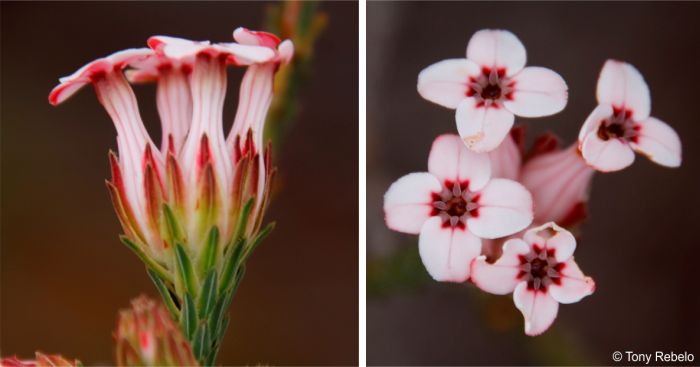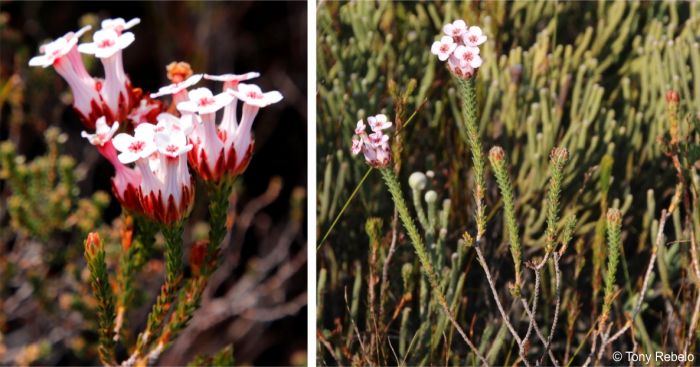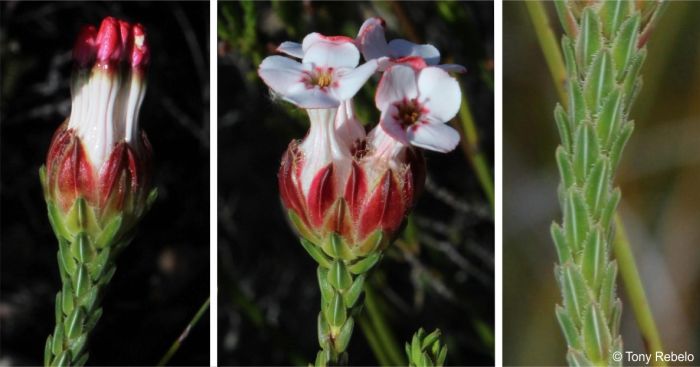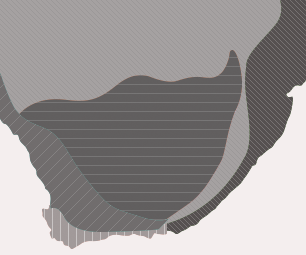Erica ampullacea
Erica ampullacea Curtis
Family: Ericaceae
Common names: flask heath, bottle heath, heath sissie (Eng.); sissieheide, flessieheide, bottelheide (Afr.)
Introduction
Erica ampullacea is a distinctive and beautiful evergreen shrub known for its dense clusters of vibrant white and pink to magenta, flask-shaped flowers.

Description
Description
Erica ampullacea is a small, often sparsely branched, thin-stemmed shrub to 600 mm tall. The leaves are small, stiff, packed closely together along the stems and extend up to the base of the flowers. The stems end in a compact cluster of four pink and white flowers. The corolla is tubular but swollen at the bottom, before narrowing to a neck just below the lobes that spread outwards. Since the flowers don't have noticeable stalks, the leaves seem to surround the flowers, which stand upright. Flowering time is in winter, spring and early summer, from late June to mid-December.
There are two varieties recognized within Erica ampullacea: var. ampullacea and var. obbata (Andrews) Bolus, a form that occurs near the coast. However, there are no constant characteristics that separate these two varieties and it seems that they have been kept purely in convenience of reference to old figures.
Erica ampullacea is a sister taxon to Erica shannonea, and both are believed to be pollinated by long-proboscid flies based on their corolla length and lobe shapes. These species are similar to each other in that they both have white to light pink flowers that are ampullaceous (bottle-shaped), they have a constricted corolla opening with flaring lobes and they are both scentless to humans. There is some overlap of the flowering times between these two species: E. shannonea flowers from late October to mid-December and E. ampullacea flowers from late June to mid-December. However, they differ in orientation and size of the flowers: E. ampullacea has corollas measuring 13–24 mm in length and facing upwards, while E. shannonea has corollas that are 22–33 mm long and face sideways.

Conservation Status
Status
The Red List of South African Plants assesses Erica ampullacea var. ampullacea as Least Concern (LC), as it does not meet any criteria for a threatened status. Erica ampullacea var. obbata has been assessed as Data Deficient - Taxonomically Problematic (DDT), more work is needed to determine the status of this variety.
Distribution and habitat
Distribution description
Erica ampullacea is found on slopes and hills in the Riviersonderend Mountains from Genadendal to Caledon to Bredasdorp, and closer to the coast in the Agulhas National Park, at Pearly Beach, Elim and Viljoenshof, and at Phillipskop Mountain Reserve near Stanford, in the Western Cape Province of South Africa. The climate is temperate, with cool, rainy winters and hot, dry summers.
Derivation of name and historical aspects
History
The genus Erica is one of the largest of the southern African clades, and comprises approximately half of the exceptional species richness within South Africa's Cape Floristic Region (CFR). Currently, around 840 species of Erica are recognized, with about 680 species occurring in the CFR. The name Erica is derived from the Greek word ereike, which was their name for heaths a few thousand years ago. The Greek word ereiko is translated to mean ‘to break’ as the tea made from the heath leaves were known to break or dissolve gallstones. The species name ampullacea is derived from the Latin word ampulla which refers to a small, rounded flask-like vessel used to hold holy water or oil.

Ecology
Ecology
Erica ampullacea flowers were observed to be visited by insects. The vertically oriented flowers are pollinated by Prosoeca westermanni (Nemestrinidae), which has a shorter proboscis that can swivel downwards. This heath requires pollinator visits for seed production, suggesting that pollinators could strongly influence flower evolution. Its unscented, long tubed flowers are consistent with adaptations for pollination by long-proboscid flies.
Uses
Use
The flowers can be used as beautiful additions to floral arrangements. In the garden, Erica ampullacea is best suited to fynbos gardens or coastal gardens with a mild Mediterranean-type climate, or containers.
Growing Erica ampullacea
Grow
Erica ampullacea is not often seen in cultivation. It flourishes in full sunlight in a well-ventilated area, in acidic, well-drained soils, particularly those with a sandy or peaty composition, and requires minimal maintenance and has low nutrient needs. The best time to plant is in autumn, with a spacing of about 30 cm between individual plants to allow for adequate growth. Propagation is achieved through seeds or cuttings.
The water requirements of E. ampullacea are moderate. It thrives in well-drained, sandy soils, and overwatering should be avoided to prevent waterlogging. Planting on a slope can also prevent waterlogging. Irrigation is recommended once or twice per week, depending on climatic conditions. Apply well-rotted compost as a mulch in autumn and spring – this provides nutrients, keeps the roots cool and suppresses weed growth. One annual application of a slow-release fertilizer specifically formulated for acid-loving plants, applied in autumn, is sufficient to support growth. Excessive fertilization should be avoided, as it may lead to root damage or nutrient toxicity. Pinching the tips of young plants will result in more bushy, floriferous growth, but regular pruning is not needed for E. ampullacea; although occasional trimming can stimulate denser growth and enhance flowering. Pruning is should take place just before new growth in late summer or autumn.
Erica ampullacea can be propagated by seeds or cuttings. Propagation by seed is the most common method. Mature seeds should be collected and sown in late summer to autumn in a well-draining medium such as one composed of peat and sand. Germination usually occurs within 2–3 weeks under ideal conditions. Cuttings can also be an effective propagation method, especially if there are stems without flowering buds. Cuttings should be taken in spring or autumn. Semi-hardwood tip or heel cuttings 10–15 cm in length should be taken, with the lower 5 cm of foliage removed. The cuttings should be treated with a rooting hormone, and planted in a well-draining medium, and placed in a misting unit on heated benches, under indirect light so that rooting can take place.
One of the significant diseases that affect this species is Phytophthora root rot. This disease is caused by the soil-borne pathogen Phytophthora cinnamomi, which leads to wilting and plant death. To avoid infection, plant in well-draining soils, keep root-disturbance to a minimum and do not over water. Removal of infected plants and improvement of soil drainage are essential for management.
References
- Bolus, H., Guthrie, F. & Brown, N.E. 1909. Ericaceae. Flora capensis 4(1):2–418.
- McCarren, S., et al. 2023. Flowering orientation and corolla length as reproductive barriers in the pollination driven divergence of Erica shannonea and Erica ampullacea. Plant Biology 25(7):1083–1090.
- Nelson, E.C. & Oliver, E.G.H. 2004. Cape heaths in European gardens: the early history of South African Erica species in cultivation, their deliberate hybridization and the orthographic bedlam. Bothalia 34(2):127–140.
- Oliver, E.G.H. 1972. Erica, a remarkable genus. Veld & Flora 58(1):57–60.
- Phillipskop Mountain Reserve. Flask Heath. https://www.phillipskop.co.za/flora/erica-ampullacea. Accessed 6 September 2024.
- Pirie, M.D., Oliver, E.G.H. & Bellstedt, D.U. 2011. A densely sampled ITS phylogeny of the Cape flagship genus Erica L. suggests numerous shifts in floral macro-morphology. Molecular Phylogenetics and Evolution 61(2): 593–601.
- Raimondo, D., Von Staden, L., Foden, W., Victor, J.E., Helme, N.A., Turner, R.C., Kamundi, D.A. & Manyama, P.A. (eds) 2009. Red list of South African plants. Strelitzia 25. South African National Biodiversity Institute, Pretoria.
- Rebelo, A.G., Siegfried, W.R. & Oliver, E.G.H. 1985. Pollination syndromes of Erica species in the south-western Cape. South African Journal of Botany 51(4):270–280
- Rebelo, T. 2024. Observations of Erica ampullacea. iNaturalist. Online. https://www.inaturalist.org/observations?taxon_id=584652&user_id=tonyrebelo.
- Schumann, D., Kirsten, G. & Oliver, E.G.H. 1992. Ericas of South Africa. Fernwood Press, Vlaeberg.
- Smith, C.A. 1966. Common names of South African plants. Memoirs of the Botanical Survey of South Africa No. 35. Government Printer, Pretoria.
Credits
Samkelisiwe Mathonsi & Aarifah Jakoet
Compton Herbarium
February 2025
Acknowledgements: the authors thank Tony Rebelo for giving permission to use his photographs.
Plant Attributes:
Plant Type: Shrub
SA Distribution: Western Cape
Soil type: Sandy
Flowering season: Spring, Early Summer, Winter
PH: Acid
Flower colour: White, Pink
Aspect: Full Sun
Gardening skill: Average
Special Features:
Horticultural zones







Rate this article
Article well written and informative
Rate this plant
Is this an interesting plant?
Login to add your Comment
Back to topNot registered yet? Click here to register.